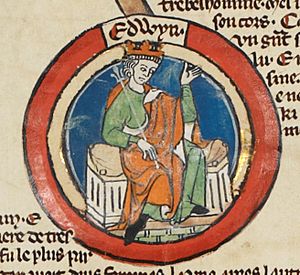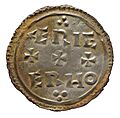Eadwig facts for kids
Quick facts for kids Eadwig |
|
|---|---|

Eadwig in the early fourteenth-century Genealogical Roll of the Kings of England
|
|
| King of the English | |
| Reign | 23 November 955 – 1 October 959 |
| Predecessor | Eadred |
| Successor | Edgar |
| Born | 940/941 |
| Died | 1 October 959 (aged c. 19) |
| Burial | New Minster, Winchester |
| Spouse | Ælfgifu (annulled) |
| House | Wessex |
| Father | Edmund I |
| Mother | Ælfgifu |
Eadwig (also known as Edwy or Eadwig All-Fair) was a King of England from 955 until his death in 959. He was the older son of Edmund I and his first wife Ælfgifu. Eadwig and his brother Edgar were very young when their father died in 946. Because they were too young to rule, their uncle Eadred became king.
Eadwig became king in 955 when he was about fifteen years old. He ruled for only four years, dying in 959 at around age twenty. Early in his reign, he had a disagreement with Dunstan, a powerful church leader who was the Abbot of Glastonbury. Dunstan was later sent away to Flanders. Eadwig was sometimes seen as being against monasteries, but many historians today think this idea is not fair.
In 957, the kingdom was divided. Eadwig kept the land south of the River Thames, and Edgar became king of the land north of it. Historians are not sure if this division was planned or if it happened because of a revolt against Eadwig. The next year, Oda, the Archbishop of Canterbury, said that Eadwig and his wife Ælfgifu could not be married anymore because they were too closely related. When Eadwig died in 959, Edgar became king of the whole kingdom.
Contents
Eadwig, King of England
Eadwig's time as king was short and full of challenges. He was the first king in a long time who did not have to worry about immediate attacks from Vikings. However, he faced problems within his own kingdom.
Early Life and Family
Eadwig was born around 940. His mother, Ælfgifu, died in 944. She was buried at Shaftesbury Abbey and was seen as a saint there. Eadwig and his younger brother Edgar were very young when their father, King Edmund, died in 946. Their uncle, Eadred, then became king.
Eadred never married, so Eadwig and Edgar were next in line for the throne. Eadwig was called "prince" in official documents during Eadred's reign. This showed he was a royal heir.
Becoming King
Eadwig became king on November 23, 955, when he was about fifteen. He was crowned at Kingston upon Thames, likely in early 956. After the crowning, there was a big feast for the king and his important nobles.
At this feast, Eadwig reportedly left early to spend time with some women. This upset the nobles and church leaders, especially Dunstan, the Abbot of Glastonbury. Dunstan was a very important figure in the church. He and another relative, Cynesige, went to bring Eadwig back to the feast. This event led to a serious disagreement between Eadwig and Dunstan.
Challenges and Conflicts
The information about Eadwig's reign is not always clear, and historians have different ideas about what he was like and what happened. The main disagreements are about his marriage and the division of the kingdom.
Eadwig and Dunstan
After the incident at the coronation feast, Dunstan was sent away from England. Some people at the time believed this happened because of the women Eadwig was with, especially Æthelgifu, who was the mother of Eadwig's future wife.
Historians today often see this story as a way to make Eadwig look bad. Dunstan was a strong supporter of the Benedictine reform movement, which wanted stricter rules for monasteries. Eadwig's actions might have been seen as going against these reforms. However, Eadwig also gave land to monasteries, showing he was not completely against them. His conflict with Dunstan seems to have been more personal.
His Marriage
Eadwig married a woman named Ælfgifu. She came from a very important family in Wessex. This marriage was politically important for Eadwig to strengthen his power.
However, in 958, Archbishop Oda separated Eadwig and Ælfgifu. The reason given was that they were "too closely related." At that time, the church had strict rules about who could marry based on family connections. This rule made it hard for royal families to find suitable partners who were not related in some way. Most historians agree the marriage was ended.
Dividing the Kingdom
In the summer of 957, the kingdom of England was divided. Eadwig remained king of the southern part, south of the River Thames. His brother, Edgar, became king of the northern part.
For a long time, historians thought this division happened because Eadwig was a bad ruler and the people in the north rebelled. However, more recent historians have different ideas. Some think it might have been a planned event, perhaps because Edgar was old enough to rule his own part of the kingdom. The official records at the time described it as a "succession" for Edgar, which sounds like a normal event.
Even after the division, Eadwig seemed to keep some higher authority. Coins were still made in his name across the whole kingdom until he died. This suggests that the division might have been a way for the brothers to share power peacefully, rather than a forceful takeover.
What Happened Next
After the kingdom was divided, Edgar, as king of the north, brought Dunstan back from exile. This showed his disapproval of Eadwig's actions against Dunstan. Edgar also gave back property to his grandmother, Eadgifu, who had lost it when Eadwig became king.
Eadwig continued to rule the south. He appointed new important officials, including Ælfhere, who became a powerful leader in Mercia. These appointments show Eadwig was trying to build his own group of supporters.
Eadwig's Legacy
Eadwig died on October 1, 959. He was buried in the New Minster, Winchester. This church was a special burial place for earlier kings like Alfred the Great. Eadwig was the only later king to be buried there.
For a long time, Eadwig had a bad reputation. Writers from Edgar's time, especially those who supported the Benedictine reform movement, often described Eadwig as irresponsible and unfit to rule. They praised Edgar and made Eadwig look bad.
However, some people at the time had a more positive view. The historian Æthelweard, who might have been Eadwig's brother-in-law, wrote that Eadwig was called "All-fair" because of his great beauty and that he "deserved to be loved." The New Minster, where he was buried, also remembered him kindly.
Modern historians often disagree with the harsh judgments of the past. They point out that the early stories about Eadwig were written by people who were against him, especially Dunstan's supporters. These historians suggest that Eadwig was a king who tried to manage the powerful families in England. They believe that much about his reign is still unclear due to the conflicting historical records.
Images for kids
-
Edwy and Elgiva, A Scene from Saxon History; William Hamilton, 1793
See also
 In Spanish: Edwy el Bello para niños
In Spanish: Edwy el Bello para niños





